Outgoing Calls
The Outgoing Calls tools let you handle all aspects of outgoing calls. It is comprised of three tabs: Outgoing Call Rules; Caller ID Rules; and Call Diagnostics. All rules are displayed in a table on the Outgoing Call Rules page. Clicking the Create Outgoing Call Rule button displays the Outgoing Call Rule page.
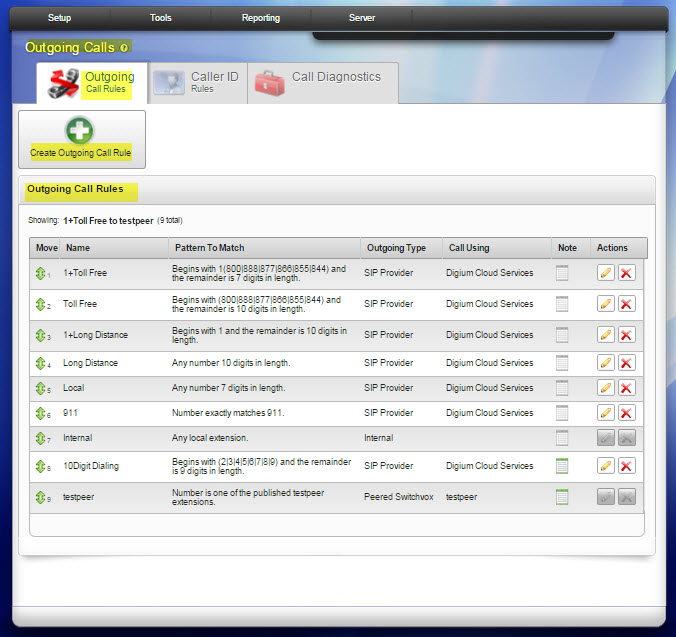
Outgoing Call Rules Tab
An outgoing call rule is a dialing pattern and associated routing information. For example, the International outgoing call rule is triggered when a user dials “9011” followed by 7 to 13 digits. Such calls are sent to the selected route (such as a VOIP provider or a Channel Group).
You can create multiple call rules that match the same pattern. In this case, if there is a pattern match, the rule that is highest in the priority list gets called first. If that rule fails, and it is not marked as a final rule, the next rule is called, and so on.
Switchvox is preconfigured with a set of outgoing call rules that serve most situations. You can modify or delete those Rules, and create your own.
Create Outgoing Call Rule
Clicking the
Create Outgoing Call Rule button displays the
Create Outgoing Call Rule page.
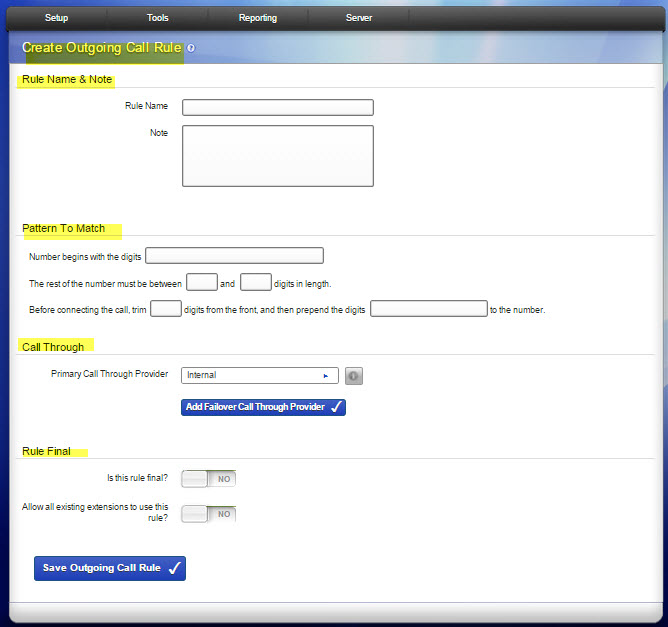
Provide the following information:
- Rule Name: A unique name for this rule.
- Note: A descriptive note for this item. This is displayed when you hover over the note icon.
- Pattern to match:
- Number begins with the digits [ ]
- Enter any required precall numbers; for example, Switchvox normally requires dialing a 9 for an outside call. In this case, enter 9 in this box.
- After the precall digit, enter the pattern you want to match. You can use any digit 0 through 9, pound (#), asterisk (*), and the plus sign (+) to describe a pattern. If a call uses the pattern exactly as described, then the rule is applied.
- You can also match multiple patterns in the same rule by using parenthesis and the pipe (|). To do this, put all of the possible patterns between parentheses and separate
- them with a pipe. The default rule Toll Free is a good example: 91(800|888|877|866).If a call begins with 91800, 91888, 91877, or 91866, then the rule is applied.
- The rest of the number must be between [] and [] digits in length.
- Enter the length of a telephone number; for example, a local number must be exactly 7 digits. In this case, enter 7 in both boxes.
- Before connecting the call, trim [] digits from the front,
- Enter the number of digits to trim when dialing; for example, enter 1 to remove the prepended 9 from the number sent to the provider.
- and then prepend the digits [] to the number.
- Enter the digits to prepend to the telephone number; for example, enter 1 and the area code for the number.
- Call through
- This indicates which of your Channel Groups or Providers to use for this call, or it is an internal call (within Switchvox).
- Failover Call Through lets you set up to 5 more providers if Switchvox cannot place the call through the previous provider. This helps you protect against downtime if one of your providers is experiencing technical difficulties.
- Switchvox tries to complete the call in the order that the Failover Providers are shown.
- Rule Final
- Is this rule final?
- If Yes (the default), when a call matches this rule but the route fails, then Switchvox does not look for additional matching rules and the call is not completed.
- If No, when a call matches this rule but fails, Switchvox looks for another matching rule, and the call might be completed.
- One reason that the routing might fail is if the extension is denied permission to use the outgoing rule.
- NOTE: One reason the routing might fail is if the extension is denied permission to use the outgoing rule.
- Allow all existing extensions to use this rule?
- This options appears upon creation of the Rule, but is not present when Modifying an existing Rule.
- If set to YES, upon creation, the Rule will be added as Allowed for all extensions.
- Emergency Calling Rule
- This option was introduced in Switchvox version 7.8.
- Set to YES if this rule is used to route emergency calls. When calls are placed using this rule, Switchvox will generate an Emergency Dialing Alert. For additional important information, please see How do I Set Up Switchvox for Emergency Dialing?
Outgoing Caller ID Rules Tab
Outgoing Caller ID rules let you modify the outgoing caller ID name and number.
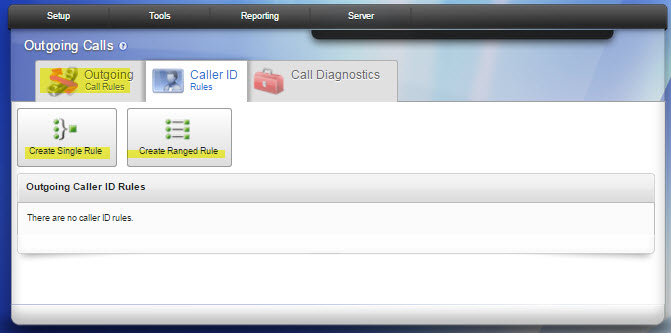
Caller ID rules can apply to:
- A single extension.
- A range of extensions.
- An extension group (use All Extensions if you want the rule to apply to everyone).
If you use a ranged Caller ID rule, you can derive an extension’s correct caller ID by adding and prepending numbers to the extension. For example, if you have an extension block from 100 to 200, and a DID block of 800-555-1200 - 800-555-1300, you would use the following ranged rule:
When an extension is in the range from 100 to 200 and is making an outgoing call through rule Any Outgoing Rule, change their caller id to a number derived by adding 100 to their extension and prepending 8005551.
NOTE: Not all VOIP providers support this feature and some VOIP providers do not work properly with altered Caller IDs. Also, it is not possible to set Caller ID on regular analog phone lines.
Create Single Rule
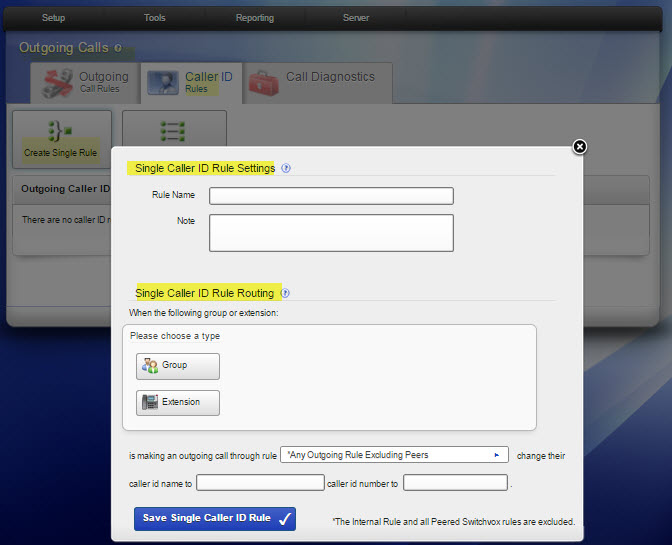
Create Ranged Rule
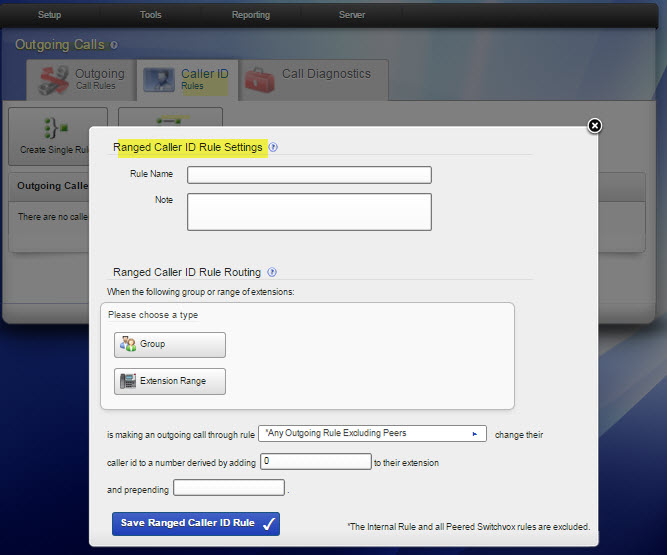
Outgoing Call Diagnostics Tab
Outgoing Call Diagnostics can be used to determine which Outgoing Call Rule is being used and why.
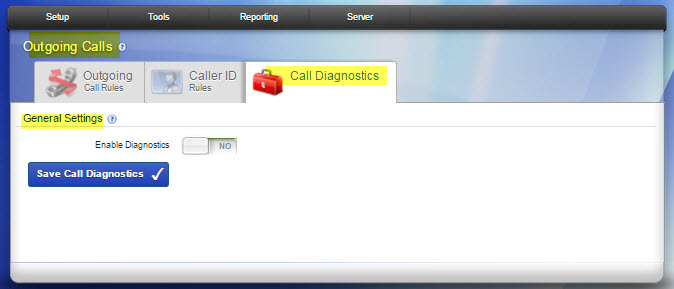
Enable Diagnositics. If set to YES, diagnostic information is read over the phone to all callers from all extensions.
For example, If you were to Enable Diagnostics and then dial an internal extension (800), instead of connecting the call, the system would read back, “You have dialed, eight zero zero. This call will be sent to outgoing rule number seven. This rule will send the call to extension eight zero zero. Press one to attempt this call through rule number seven.” As outgoing calls become more complex by trimming or appending digits, altering Caller ID, or matching multiple outgoing call rules, the diagnostic information provided will become more complex.
Listening to the diagnostic information and following the voice prompts provides insight into the path that calls are taking in the system to solve calling problems or unexpected call behavior taking place in the system. For example, the diagnostic may reveal that a call is using the wrong rule.
When using the Diagnostic mode, make sure the number you are dialing matches the pattern for the rule. If the pattern does not match, your outgoing call will not be connected using that rule. If the number you have dialed does match the pattern for the rule, make sure the extension you are placing the call from has permission to call through that rule (see “Outgoing Call Rules” above).
rel7.8



